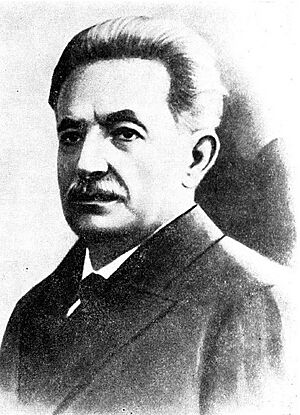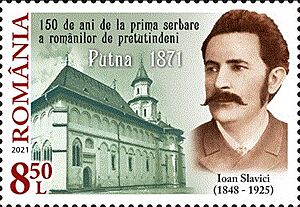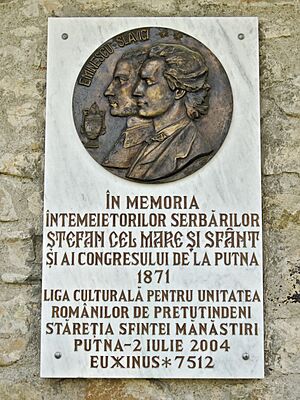Ioan Slavici facts for kids
Quick facts for kids
Ioan Slavici
|
|
|---|---|
 |
|
| Born | 18 January 1848 Világos, Austrian Empire (today Șiria, Arad County, Romania) |
| Died | 17 August 1925 (aged 77) Panciu, Putna County, Kingdom of Romania |
| Resting place | Brazi Monastery, Panciu, Romania |
| Occupation | Writer, journalist |
| Language | Romanian |
| Nationality | Romanian |
| Citizenship |
|
| Education |
|
| Genre | Novel, novella, play, fairy tale |
| Literary movement | Naturalism |
| Notable works | Zâna Zorilor (1872) Moara cu noroc (1880) Budulea Taichii (1880) Pădureanca (1884) Mara (1894) |
| Spouses |
Katalin Szőke Magyarósy
(m. 1875; div. 1885)Eleonora Tănăsescu
(m. 1886) |
| Children |
|
Ioan Slavici (born January 18, 1848 – died August 17, 1925) was an important Romanian writer and journalist. He was born in Austria-Hungary and later became a citizen of Romania.
He started his writing career in 1871 with a comedy play called Fata de birău ("The Mayor's Daughter"). He also helped start the Young Romania Social and Literary Academic Society with Mihai Eminescu, a famous Romanian poet. In 1871, they organized a big event called the Putna Celebration for Romanian students.
Later, Slavici moved to Bucharest. He worked as a secretary and then as a professor. He also became an editor for the newspaper Timpul ("The Time"). He worked with other famous writers like Ion Luca Caragiale and George Coșbuc on a magazine called Vatra ("The Hearth"). During World War I, he wrote for newspapers like Ziua ("The Day") and Gazeta Bucureștilor ("The Bucharest Gazette"). He received the Romanian Academy Award in 1903 for his work.
Contents
Early Life and Education
Ioan Slavici was born in 1848 in a village called Világos, which is now Șiria, Romania. His parents were Sava and Elena Slavici. He went to school at the local Orthodox school in Șiria. He also studied at other schools in Transylvania, where classes were taught in Hungarian or German. He joined a group called the Romania Lecture Society.
After finishing school, Slavici started studying law in Budapest in 1868 and then in Vienna in 1869. However, he faced money problems and had to go back home. He took a job as a notary public to earn money. He saved up enough to continue his studies in Vienna later on.
Joining the Junimea Society
In 1871, Slavici went to Vienna for his military service. This was a very important time for him because he met Mihai Eminescu there. Eminescu was the most important Romanian poet, and he was studying at the University of Vienna. They became good friends. Eminescu helped Slavici improve his writing style and encouraged him with his stories.
In the same year, Slavici's first writings were published in Convorbiri Literare. This was a magazine for the Junimea society, a famous literary group in Iași.
In 1872, Slavici had to stop his studies again because of money issues. Two years later, he moved from Austria-Hungary to Iași. There, he became an active member of the Junimea group. In 1874, the Ioan Slavici Classical Theatre was founded in Arad. His first book, Nuvele din popor, was a collection of short stories published in 1881. It included two of his most famous works: Moara cu noroc (The Lucky Mill) and Budulea Taichii.
Challenges and Return to Bucharest
In 1882, Ioan Slavici became a member of the Romanian Academy. In 1884, he moved to Transylvania and became very involved in the Romanian national movement. He was a member of the Central Committee of the Romanian National Party, which was a main group for Romanians in that area. Because of his strong national views, the Hungarian authorities had disagreements with him.
Six years later, he moved to Bucharest. In 1894, he started publishing parts of his most famous novel, Mara. The full book was published 12 years later. During this time, he also worked as an editor for the Vatra magazine with George Coșbuc and Ion Luca Caragiale.
World War I and Later Years
In 1909, Slavici started working for a newspaper called Ziua, which supported Germany. When World War I began, his articles caused disagreements with other thinkers who supported the other side, the Triple Entente. On August 14, 1916, Romania joined the war on the Entente side and attacked Hungary. After some time, German and Austro-Hungarian forces took over most of Romania, including Bucharest.
The Romanian government moved to Iași, and the Central Powers set up a temporary government in the occupied areas. Slavici worked with this new government as an editor for their official newspaper, the Bucharest Gazette. After the German forces left in November 1918, Slavici faced questions about his actions during the war. This caused his reputation among other intellectuals to suffer.
In 1925, Slavici went to stay with his daughter in Panciu. He passed away there later that year and was buried at the hermitage within Brazi Monastery.
Legacy
Ioan Slavici is remembered through several places named in his honor. The Ioan Slavici Classical Theatre in Arad and the Ioan Slavici National College in Satu Mare are named after him. Streets in cities like Arad, Baia Mare, Bistrița, Satu Mare, Suceava, and Timișoara also carry his name.
Works

Theatre
- Comedy
- Fata de birău (1871)
- Toane sau Vorbe de clacă (1875)
- Polipul unchiului (1875)
- Bogdan Vodă (1876)
- Gaspar Graziani (1888)
Fairy tales
- "Zâna Zorilor", in English "The fairy Aurora"
- "Florița din codru"
- "Doi feți cu stea în frunte", in English "The twins with the golden star"
- "Păcală în satul lui"
- "Spaima zmeilor"
- "Rodul tainic"
- "Ileana cea șireată"
- "Ioanea mamei"
- "Petrea prostul"
- "Limir-împărat"
- "Băiet sărac"
- "Împăratul șerpilor"
- "Doi frați buni"
- "Băiat sărac și horopsit"
- "Nărodul curții"
- "Negru împărat"
- "Peștele pe brazdă"
- "Stan Bolovan"
- "Boierul și Păcală"
Novellas
- Popa Tanda (1873)
- Scormon (1875)
- La crucea din sat (1876)
- Crucile roșii (1876)
- O viață pierdută (1876)
- Gura satului (1878)
- Budulea Taichii (1880)
- Moara cu noroc (The Mill of Good Luck, 1880)
- Pădureanca (1884)
- Comoara (1896)
- Vatra părăsită (1900)
- La răscruci (1906)
- Pascal, săracul (1920)
Novels
- Mara (1894)
- Din bătrâni (1902)
- Din bătrâni. Manea (1905):)
- Corbei (1906)
- Din două lumi (1920)
- Cel din urmă armaș (1923)
- Din păcat în păcat (1924)
Memoires
- Fapta omenească. Scrisori adresate unui tânăr (1888–1889)
- Serbarea de la Putna (1903)
- Închisorile mele (1920)
- Amintiri (1924)
- Lumea prin care am trecut (1924)



